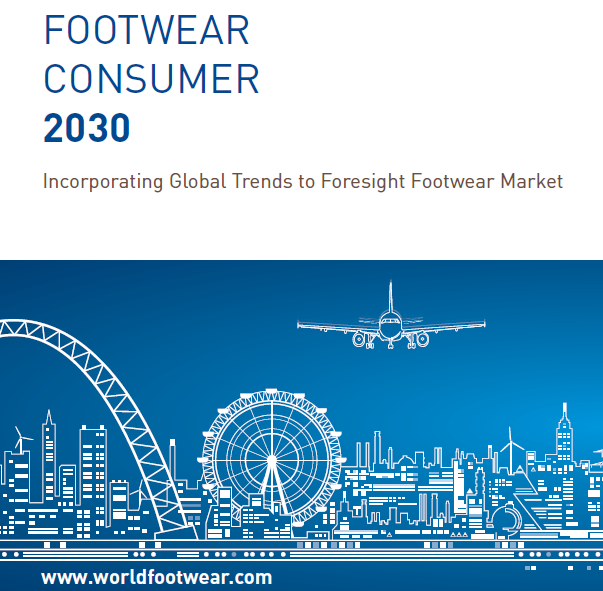Is economic power shifting back to Asia?

The study Footwear Consumer 2030 predicts that in the next 15 years the economic dynamics, the geographic shifts in production and the consumer preferences will influence the decisions of the footwear industry
Study available here.
If we go back to 1700, India represented roughly 25% of the world GDP, China had a little more than 20%, Japan less than 5%, a set of three European countries (UK, Germany and France) had a share just slightly above 10%, and the US had a residual share. In 1950 the US peaked with a share of the world GDP slightly above 25%, corresponding to an historical minimum contribution by China (just below 5%). At that time, India was still registering a decline in its contribution to global GDP. In 2000 China and India presented growing trends, while the other three blocs continued to decline their share of the world GDP, a trend which is expected to continue in the years to come.
Emerging markets and developing economies have been more dynamic in the recent evolution of GDP and the forecasts for the next few years indicate the maintenance of this trend. By 2019 advanced economies will represent 40% of the world GDP, ie, at a level slightly below the contribution of emerging and developing economies in 1995.
This obviously represents a change in the commonly accepted paradigm, as throughout the last decades consumption and production presented dynamics of growth that were geographically distinctive: consumer spending growth was mainly associated to the US, Japan and European countries and manufacturing activity was mainly identified with Asian countries. As the US and EU economies were hit with recession and now grow at a slower pace, they will tend to import less (while focusing on increasing exports), and China and other Asian economies will have to shift away from the current model of economic growth based on exports to focus on their domestic market. As a result a significant share of the global growth of consumer spending will take place in emerging markets, and this will have implications for companies and brands worldwide.
Ferragamo and Prada, two famous luxury product’s retailers are already very active in their presence in the Asian region, having increased their local sales significantly over the last years. As of 31st December 2007, the Asia Pacific region (excluding Japan) represented 26.1% in total revenue from the core business of the Ferragamo. Recent numbers presented by the group confirm a share of 37.8% for the Asia Pacific market in total revenue as of 30th June of the current year. As for the Prada group, and going back to the beginning of 2009 (31st January) revenue generated in the Asia Pacific region reached 282.7 million euros, growing more than 350% in just 5 years to reach 1 292.8 million euros by the end of January 2014.
As consumption shifts from the traditional markets, an extra effort is demanded from brands and companies to understand the different consumer preferences, which will impact the own product’s development. Also, companies will expand into countries where strong local competitive players already market their products, benefiting from in-depth know how about the local market.
Different market strategies might also co-exist, namely in terms of price tags. Developed economies placing their products in emerging markets will face different price strategies: they will compete with local manufacturers with low price products produced in those countries; but they will aim to position products manufactured in the developed world and commercialised in emerging markets at a higher price range.
Also, as income rises and as economic growth consolidates, those living in extreme poverty start to have access to new opportunities that allow them to escape that status and push down poverty levels. Some studies point to a reduction by 50% between 2010 and 2030 and the drop in the number of those living in extreme poverty has been quite substantial in East Asia already, especially in China, where more than half its population was living below the poverty line (60.2%) in 1990.
Economic growth will also result in a growing middle class. According to a study presented by Ernst & Young, in 2009 there were 1.8 billion people considered middle class. By 2030 that number is expected to almost triple and reach 4.8 billion people, representing roughly 3 billion new consumers joining the middle class. As this number grows, purchasing power will tend to increase resulting in additional consumption, and even increment of savings.
The conjunction of the different elements of this scenario in developing and emerging countries, with the middle class growing while the number of people shifting poverty increases and the economy as a whole develops, result in huge additional consumption within the next few years, which makes these very important and attractive markets for companies and brands.
If we go back to 1700, India represented roughly 25% of the world GDP, China had a little more than 20%, Japan less than 5%, a set of three European countries (UK, Germany and France) had a share just slightly above 10%, and the US had a residual share. In 1950 the US peaked with a share of the world GDP slightly above 25%, corresponding to an historical minimum contribution by China (just below 5%). At that time, India was still registering a decline in its contribution to global GDP. In 2000 China and India presented growing trends, while the other three blocs continued to decline their share of the world GDP, a trend which is expected to continue in the years to come.
Emerging markets and developing economies have been more dynamic in the recent evolution of GDP and the forecasts for the next few years indicate the maintenance of this trend. By 2019 advanced economies will represent 40% of the world GDP, ie, at a level slightly below the contribution of emerging and developing economies in 1995.
This obviously represents a change in the commonly accepted paradigm, as throughout the last decades consumption and production presented dynamics of growth that were geographically distinctive: consumer spending growth was mainly associated to the US, Japan and European countries and manufacturing activity was mainly identified with Asian countries. As the US and EU economies were hit with recession and now grow at a slower pace, they will tend to import less (while focusing on increasing exports), and China and other Asian economies will have to shift away from the current model of economic growth based on exports to focus on their domestic market. As a result a significant share of the global growth of consumer spending will take place in emerging markets, and this will have implications for companies and brands worldwide.
Ferragamo and Prada, two famous luxury product’s retailers are already very active in their presence in the Asian region, having increased their local sales significantly over the last years. As of 31st December 2007, the Asia Pacific region (excluding Japan) represented 26.1% in total revenue from the core business of the Ferragamo. Recent numbers presented by the group confirm a share of 37.8% for the Asia Pacific market in total revenue as of 30th June of the current year. As for the Prada group, and going back to the beginning of 2009 (31st January) revenue generated in the Asia Pacific region reached 282.7 million euros, growing more than 350% in just 5 years to reach 1 292.8 million euros by the end of January 2014.
As consumption shifts from the traditional markets, an extra effort is demanded from brands and companies to understand the different consumer preferences, which will impact the own product’s development. Also, companies will expand into countries where strong local competitive players already market their products, benefiting from in-depth know how about the local market.
Different market strategies might also co-exist, namely in terms of price tags. Developed economies placing their products in emerging markets will face different price strategies: they will compete with local manufacturers with low price products produced in those countries; but they will aim to position products manufactured in the developed world and commercialised in emerging markets at a higher price range.
Also, as income rises and as economic growth consolidates, those living in extreme poverty start to have access to new opportunities that allow them to escape that status and push down poverty levels. Some studies point to a reduction by 50% between 2010 and 2030 and the drop in the number of those living in extreme poverty has been quite substantial in East Asia already, especially in China, where more than half its population was living below the poverty line (60.2%) in 1990.
Economic growth will also result in a growing middle class. According to a study presented by Ernst & Young, in 2009 there were 1.8 billion people considered middle class. By 2030 that number is expected to almost triple and reach 4.8 billion people, representing roughly 3 billion new consumers joining the middle class. As this number grows, purchasing power will tend to increase resulting in additional consumption, and even increment of savings.
The conjunction of the different elements of this scenario in developing and emerging countries, with the middle class growing while the number of people shifting poverty increases and the economy as a whole develops, result in huge additional consumption within the next few years, which makes these very important and attractive markets for companies and brands.















